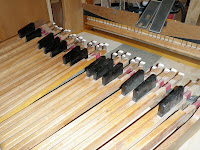Pedal Refurbishment

The pedal board needed some serious work to get it back into shape. Two of the keys were broken and needed to be replaced. The weight of touch was different on all the keys. They were rather sloppy and noisy. Plus, the whole thing was filthy! I removed all the panels for refinishing, so this was the logical time to do the pedal board as well. Each pedal is attached at the heel end by a spring. The spring returns the key as you lift your foot. They aren't attached at the toe end, they just sit between the guide pins.

I labeled each key as I removed it and then labeled and removed the return spring. The black sharps are plastic which I removed and cleaned. I then removed the maple natural covers to refinish them separately. Everything was stripped and sanded along with the other parts of the console. I also replaced the two broken keys. I used clear poplar to cut identical replacements. I used the aniline dye left over from the stop tab rail to color them to almost perfectly match the originals. Can you spot the replacement in this photo?
I wanted to refinish the pedals with water-based satin polyurethane (WB) for two reasons. It is non-yellowing, preserving the light color of the maple covers and it is almost as durable as oil-based polyurethane. WB dries very quickly, so you have to work fast. The keys themselves finished beautifully. When I went to apply it to the natural covers, I ran into a problem. By the time I got to the fifth key, I noticed that the WB on first key had crackled, lifted, and literally fell off the wood. I know I cleaned them up very well after stripping. I have no idea what went wrong. Rather than struggle with the old covers, I decided to make brand new covers. I went to Hardwood Heaven and picked out some hard maple boards and a couple new router bits. It took an afternoon of milling, routing, and sanding, but at least I was confident the WB would stick. And it did. I applied four coats, sanding lightly between coats to remove dust nibs.

While the WB cured, I turned to the loose noisy keys. The guide pin bushing felt was badly worn on most of the loose keys so I replaced all that with new felt. A few keys needed a shim under the felt too. I suppose after 80 years the wooden guide pins got worn a bit wider too. After the WB cured, I reassembled everything. I also adjusted the spring tension to just under 3 pounds of resistance which is the AGO specification. The keys are now much quiter and play with the resistance I would expect. See lots more pictures in the album, the link is below this picture.
Pedal Board Album